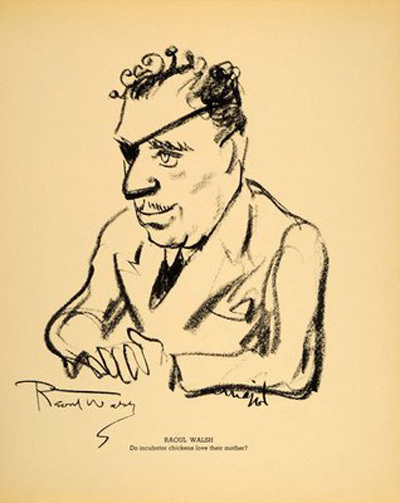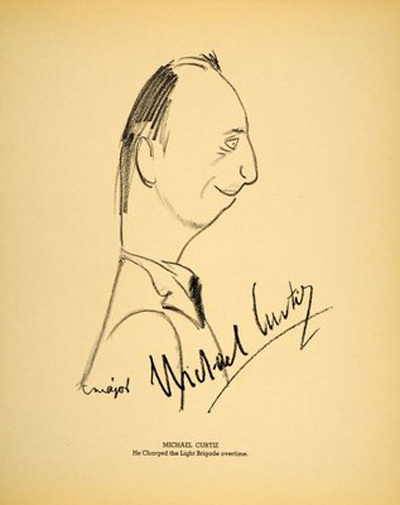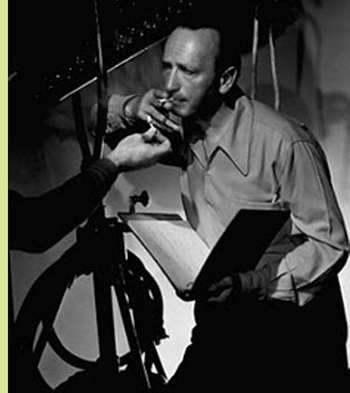— Tina
Archive for the ‘Directors’ Category
Director Raoul A. Walsh
Director Vincent Sherman
Director Vincent Sherman
(July 16, 1906 – June 18, 2006)
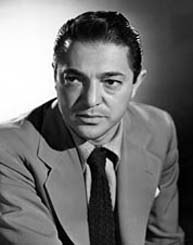
Vincent Sherman was born Abe Orovitz in Vienna, Georgia in 1906. With the South just four decades removed from the Reconstruction period, it was an incongruous location for the son of a Jewish dry-goods salesman to grow up. Sherman later described the theoretical distance between Vienna, Georgia and Hollywood, California as considerably, more than the actual two thousand miles
After graduating from Oglethorpe University, Sherman went to New York to sell a play and then hustled to become a stage actor, got married and ended up going to Hollywood in 1933 to try the movies. He made his screen debut in Counselor at Law alongside John Barrymore, but there were no follow-on roles so he returned to stage work, directing and writing as well as acting.
After touring in the stage play “Dead End”, Sherman returned to Hollywood for good in 1937. This time he landed the ubiquitous seven-year contract with Warner Brothers under producer Bryan Foy.
During his long and successful carrier, he directed many of Hollywood’s great stars like, Joan Crawford, Bette Davis, Rita Hayworth, Miriam Hopkins,Ida Lupino, Ann Sheridan, and Humphrey Bogart, Lee J. Cobb, Glenn Ford, Errol Flynn, Paul Newman, and most likely many others.
He was a good friend of actor Errol Flynn, whom he directed in “Adventures of Don Juan” (1949).
Vincent Sherman was married to Hedda for 53 years, who died.1984 and they had one son and one daughter.
Son: Eric Sherman
Daughter: Hedwin Naimark
Girlfriend: Francine York (companion for 9 years, until his death)
Vincent Sherman’s son is documentary film producer Eric Sherman.
Trivia:
Warner told the embryonic director: “I’m giving you this guy Bogart and for God’s sake, see if you can get him to play something besides Duke Mantee!” Bogart then a Warner Brothers contract player in his fourth year at the studio, Humphrey Bogart accepted the hokey part without complaint, and the film became a profitable if improbable success and with it a start to Bogart’s star carrier.
Mistress: Bette Davis (actress, on-set extramarital affair 1943-44)
Mistress: Rita Hayworth (actress, on-set affair, during “Affair in Trinidad” 1952)
Mistress: Joan Crawford (actress, on-set affair during 3 films)
— Tina
Director Raoul A. Walsh
<?xml:namespace prefix = o ns = “urn:schemas-microsoft-com:office:office” /> (March 11, 1887 – December 31, 1980)
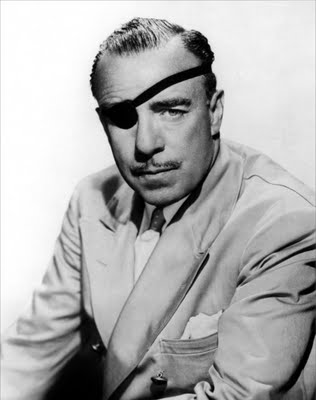
Raoul Walsh was an American film director, actor, founding member of the <?xml:namespace prefix = st1 ns = “urn:schemas-microsoft-com:office:smarttags” />Academy of Motion Picture Arts and Sciences (AMPAS) and the brother of silent screen actor George Walsh.
Walsh began as a stage actor in New York City, quickly progressing into film acting. Walsh was educated at Seton Hall College and began acting in 1909. In 1914, he became an assistant to D.W. Griffith and made his first full-length feature film “The Life of General Villa”, followed by the critically acclaimed Regeneration in 1915, possibly the earliest gangster film. Walsh played John Wilkes Booth in D.W. Griffith's epic ”The Birth of a Nation” (1915) for which he was also Assistant Director. Walsh later directed The Thief of Bagdad (1924), starring Douglas Fairbanks.
In the early days of sound with 20 Century Fox, Walsh directed the first widescreen spectacle, The Big Trail (1930), shot on location across the West. It starred then unknown John Wayne, whom Walsh discovered as prop boy by the name of Marion Morrison and renamed him after General Mad Anthony Wayne (Walsh happened to be reading a book about General Wayne at the time).
An undistinguished period followed with Paramount Pictures from 1935 to 1939, but Walsh's career rose to new heights soon after moving to Warner Brothers, making movies with Hollywood’s Greatest including Errol Flynn. He made the following movies with Errol Flynn – “They Died with Their Boots On” (1941) “Desperate Journey” (1942), “Gentleman Jim” (1942), “Northern Pursuit” (1943), “Objective Burma” (1945), “Silver River” (1948) and “Montana” (1950).
Walsh's contract at Warner Brothers expired in 1953 and made many more movies for various studios until his retirement in 1964.
Trivia:
Walsh was set to direct and star in “In Old Arizona” in 1929, but had to abandon the project when a jackrabbit jumped through the windshield of a car he was driving which cost Walsh an eye.
After losing his eye, his doctor reportedly asked if he'd like an artificial (glass) one. “Hell, no,” Walsh snapped. “Every time I'd get in a fight, I'd have to put it in my pocket.” He wore an eye patch for the rest of his life.
There are echoes in Walsh's films of events from his own life and that of his family. In “They Died with Their Boots On” (1941) there is an actor playing a bit part as a tailor to the US cavalry officers that might have been a reference to Walsh's father who made uniforms for General Custer and other high-ranking officers before becoming chief designer for Brooks Brothers in New York.
Like his contemporary Howard Hawks, Walsh was known for never letting the facts get in the way of a good story. According to Walsh, in 1942, a few days after John Barrymore had died, Walsh, as a practical joker, picked up Barrymore's body from the mortuary and managed to sit the body, clad in a business suit, in a chair in Errol Flynn's house just before Errol was due to arrive home. The artist Gene Fowler, a friend to both Barrymore and Flynn, disputed this story — recounted by both Flynn and Walsh in their autobiographies. Fowler states in his autobiography that he spent much of the night during which the joke was supposed to have occurred sitting with Barrymore's body in a Hollywood funeral home.
— Tina
Director Michael Curtiz
Director Michael Curtiz!
(December 24, 1886 – April 10, 1962)
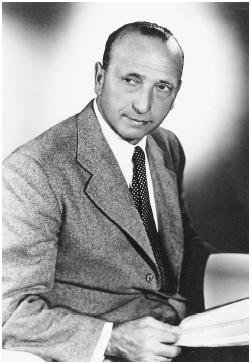
st1:*{behavior:url(#ieooui) }
Michael Curtiz
began his career as an actor and director in his native country, Hungary in
1912. He arrive in Hollywood
in 1926 and became one of Hollywood’s most
prominent film director After WWI, he
continued his filmmaking career in Austria
and Germany and into the
early 1920s when he directed films in other countries in Europe. He started making films for Warner
Brothers. His films during the 1930s and
'40s encompassed nearly every genre imaginable.
Today a very large amount of his films are classics! He directed his last film in 1961, a year
before his death at 74.
Interred at
Forest Lawn, Glendale, California in the Whispering Pines section.
Spouses:
Bess Meredyth,
December 7, 1929 – April 10, (to his death) 1962
Lili Damita:
1925 – 1926 (divorced)
Lucy Doraine
1918 – 1923 (divorced)
He had a
stepson, John Meredyth Lukas whom he adopted in 1929 when the boy was ten years
old.
His two most
fruitful collaborations with stars were with Errol Flynn (they did 12 films
together) and Humphrey Bogart (they did 8 films together). Was assigned to direct “The Adventures of Don
Juan” (1948), in 1947; however, Errol Flynn had a falling-out with him.
Trivia:
John Meredyth
Lukas said he spoke five languages, all of them badly. His thick Hungarian accent often made it
difficult for cast and crew members to understand his English. During the filming of “Casablanca” (1942), for instance, he asked a
set dresser for a “poodle” later it was discovered that, in fact, he
wanted a “poodle” (puddle) of water!
On the set of
“The Cabin in the Cotton” (1932), Curtiz made a speech on how he wanted the
actors to act like “woodpeckers” when the script described them as
“peckerwoods.”
He could be
intensely absorbed, to the point of distraction. Once he was hurt falling out of a moving car
because he wanted to write down an idea.
He was driving at the time.
As known for his
trouble with the English language it is said that during filming of ”The Charge
of the Light Brigade” (1936), he wanted many horses without riders in the
background during the final charge. His
instructions were, “Bring on the empty horses,” later the title of the
autobiography of one of the stars of the film, David Niven.
Another time he
was chewing out an assistant for neglecting to do a job assigned to him, and
yelled, “The next time I want an idiot to do this, I'll do it
myself!”
His grasp of the
English language made him the subject of many long-standing Hollywood He once
berated David Niven on set declaring: “You think you know f*ck everything
and I know f*ck nothing. Well let me
tell you, I know f*ck all!!!” anecdotes.
Nevertheless the
trivia, he was one of the great directors of Hollywood
and the greatest stars of Hollywood
owe him a lot!
— Tina
